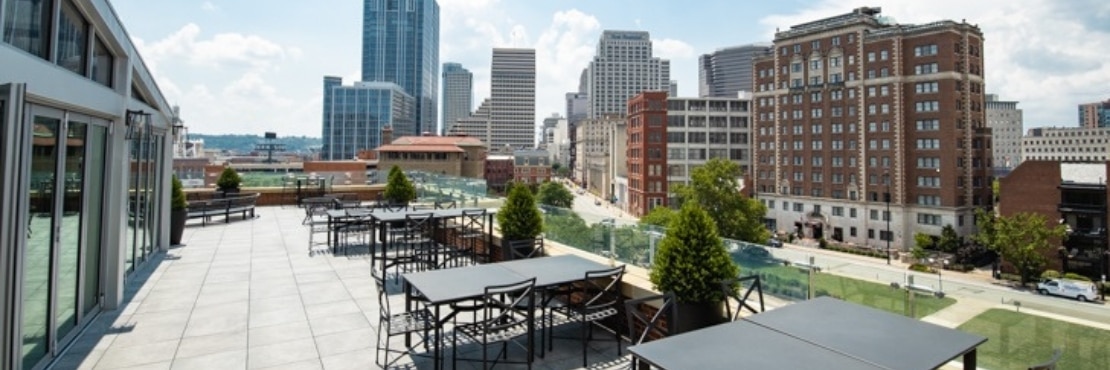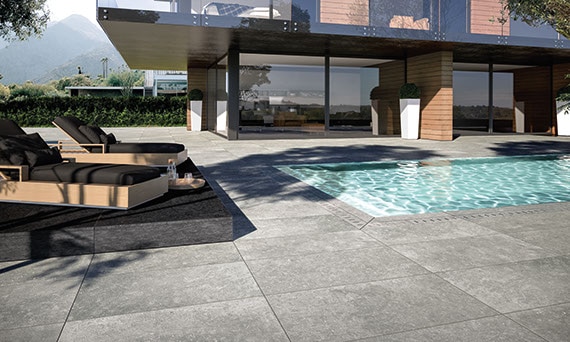
SOLAR REFLECTANCE INDEX (SRI)
• Thermal emittance is a material's ability to release the absorbed energy.
MEASURING SURFACE TEMPERATURE
How hot a surface gets in direct sunlight is a critical factor when selecting outdoor building materials. For deck coverings, pavers, or other outdoor flooring, scorching surfaces can pose a serious risk to those who come in contact with them. For roofing and outdoor walls & facades, surface temperature is a key component in energy consumption. Solar Reflectance Index measures this crucial element on a scale of 0 to 100. Materials that absorb and retain solar radiation (and thus become hotter in direct sunlight) have a lower number, while highly reflective materials (which remain cooler in direct sunlight) have a higher number.
HEAT ISLAND EFFECT
White, Cream, Light Grey
These light colors have 5-20% less heat absorption and retention than concrete. Generally, light-colored materials have higher solar reflectance than dark-colored materials.
Mid-Range Grey, Tan, Beige
These colors can have the same SRI or slightly higher (up to 5%) than standard grey concrete.
Medium-Light Grey
Medium to light grey porcelain is comparable to standard grey concrete.
Dark Grey, Black, Brown
Building materials in this color palette range have a lower SRI and often test 10-22% hotter. Darker colors will generally have more heat rise in direct sunlight and are uncomfortable on bare feet.
TREAD™ 2CM Porcelain Pavers
Test Results
* The Heat Island Reduction LEED Credit requires use of outside pavers achieving an overall project SRI result of 29 or higher.
SRI Design Considerations
• Analyze the project's ambient temperature, which will determine the importance of Solar Reflectance Index.
• It is important to note, that color is not the only indicator of reflectance. Sunlight includes ultraviolent, visible, and infrared radiation. Visible light makes up about 40% of the energy in the solar spectrum. A cool-colored material strongly reflects the invisible “near-infrared” radiation that makes up nearly half of sunlight. Replacing a standard (warm) color with a matching cool color can boost solar reflectance by as much as 0.4 without affecting appearance. (We note that a light color, such as white, is also cool, but the term “cool color” is most commonly used to describe a surface that reflects more strongly in the near-infrared spectrum than in the visible spectrum).
•Use a darker color palette in generally shady areas or colder climates.
• High SRI materials are vital for surfaces under all these conditions:
- Surface is located in a warm climate.
- Surface will be exposed to direct sunlight.
- People are likely to walk on the surface without shoes.
• If energy consumption is a consideration for your project, utilize these factors to your advantage:
- Employ low SRI materials for roofing and facades in cold climates to reduce energy consumption.
- Use high SRI materials for roofing and facades in warm climates to reduce energy consumption.
- The air gap of elevated pedestals can reduce energy consumption.
- Use Natural Stone or Panoramic Porcelain Surfaces™ on a building’s envelope to decrease urban heat island effect.
• As materials age and experience exposure to the elements, maintenance of material surfaces is key to maintaining the SRI values the materials had at the time of installation. Porcelain has low-maintenance requirements. The colors do not fade and the surface does not erode like concrete (erosion can have a negative impact on SRI). In addition, porcelain’s resistance to staining helps a light-colored porcelain paver remain cooler over time than a similarly colored concrete or natural stone paver.







